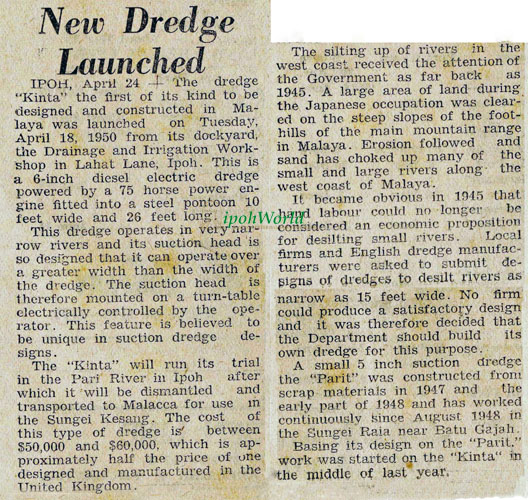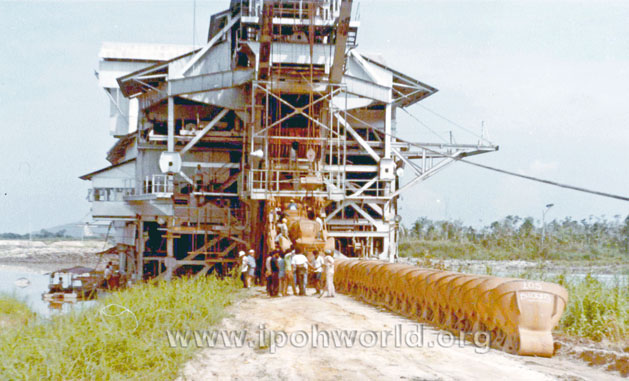Pari River had a dredge?
Yes indeed…according to this article (below) from Times of Malaya & Straits Echo.



We thank Pat Price (from Sydney) for this picture. Price was formerly an engineer with Anglo-Oriental. This dredge was said to be in Kampong Gajah, Perak. Perhaps you’re wondering why the dredge buckets are all lined up on the extreme right. Back in 1976, one of the dredge buckets broke; hence, fixing the problem was quite a task for the engineers and the coolies.
Here’s a close-up of a bucket dredge – for those of you who’ve seen an actual dredge bucket, you can imagine the size of this machine! We thank Alison Cotterill (nee Caldwell) for this photograph. From her emails, we think that this was probably part of the Keramat Tin mine in Bidor (if we’re wrong, do let us know 🙂 ).
Most photographs of dulang washers show the ladies almost knee deep in water, while they rotate their dulangs. This photo here (from Alison Cotterill nee Caldwell) shows the dulang washer in a field instead! This area was probably near Kramat Tin (Bidor). Notice the 1 cubic ft box (bottom left), and the white bowl (above the large drum). Can onyone out there tell us what these items were for?
We thank Alison for this unique photograph.
Courtesy of Jerry de Witt, this photograph taken from a MAS aircraft in 1975 clearly shows the Kinta River winding its leisurely way across the valley on its way to Teluk Intan. But don’t miss the tin mines – those large brown patches alongside the river – for in 1975 there was still a tin mining industry here, albeit approaching its “last legs”. Look carefully and you can probably spot a dredge or two clanking away and wresting the black gold from the ground.
Not so long ago was it, just 36 years, but today even though fortunes were made locally we don’t even have a suitable marker of any sort in Ipoh to remember those days gone by or, as Dr Ho Tak Ming put it, when tin was king.
Foo Nyit Tse started off as miner, under Foo Choo Choon; he later opened his first mine in 1898. In the 1920s, Foo Nyit Tse (who by then was a well known mining Towkay) built Falim – ‘a self contained housing estate, with a large num of low cost terrace housing and 40 shop houses’. Falim, which means ‘beautiful forests’, is located along Lahat Road; between Ipoh and Menglembu.
Here we have Falim House – Foo Nyit Tse’s mansion, which was built across the road from the shop houses. It was at this very mansion that Towkay Foo entertained the Who’s Who of Ipoh society back then. The picture above is the front view of the mansion; notice that on either side of the porch, there is a red, stone lion.
This picture is a side view of the mansion; on the left of the picture, seems to be what once was a courtyard – perhaps Towkay Foo had open-air parties too?
We thank Leong Yew Kee for providing us with these photos.
This information is taken from the latest post on the Ipoh Echo blog at http://ipohecho.com.my/v2/2010/01/22/state-government-to-keep-the-dredge/.
This striking decision was made public by Dato’ Hamidah Osman the Senior State Executive Councilor for Tourism via an Echo reporter on on Wednesday 20 January during an interview in Taiping to commemorate the 10th Anniversary of the Taiping Peace Initiative.
It is reported that she said “Yes, we are going to keep the dredge” . She apparently continued ” …..Besides preserving the dredge we must also ensure that it is safe and will last for the long term. ……”
She made no mention of how much budget has been set aside, but no doubt it will be several million if this is to be a genuine preservation and long term solution.
Please read the full report via the above link.
At the start of the 20th century, the above title certainly belonged to Foo Choo Choon. Prior to him the mantle of the Richest Man in the FMS changed hands several times between the late 19th century and the beginning of the 20th century, from the renowned Capitan China, Chung Keng Kwee, to the entrepreneur Loke Yew. But within the 1st decade of the 20th century, Foo Choo Choon had overtaken Loke Yew in terms of wealth. Foo Choo Choon came to Malaysia as a 13 year-old Chinese immigrant in 1873 and worked for Chung Keng Kwee in his Lahat mining concession. The bulk of his initial wealth was amassed in 1897; from his extraordinarily rich mine in Tronoh which became the richest mine in Kinta at the time. Foo Choo Choon then formed a syndicate and proceeded to obtain further mining concessions, turning himself into a mining magnate. At the turn of the century he sold his Tronoh mine to British interests who floated the mine, and made Foo Choo Choon the first Chinese director of a British listed company. After the sale of a second concession, he went on an acquisition trail that was to turn him into the Tin King of Malaya. In 1905, Tronoh Mines Ltd, of which Foo was the majority shareholder, and Foo’s own mines, topped the list of most productive mines in Perak, prompting the Ballarat Courier to refer to him as “the richest Chinaman in the world”.
The above is a summary of one of many heritage articles written by Dr Ho Tak Ming and published in the Ipoh Echo. If you don’t get the Ipoh Echo you are losing out on your heritage facts. Of course you will also be missing out on the Echo’s ‘from the shoulder’ articles.